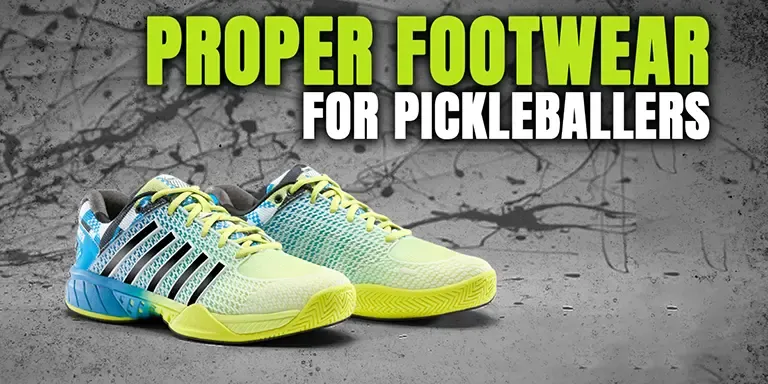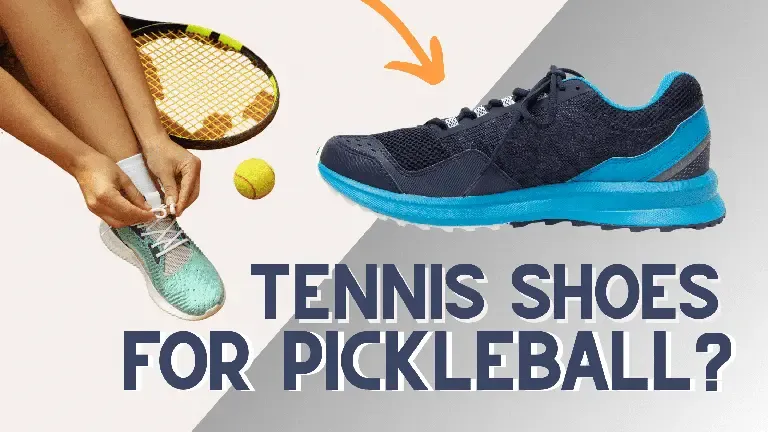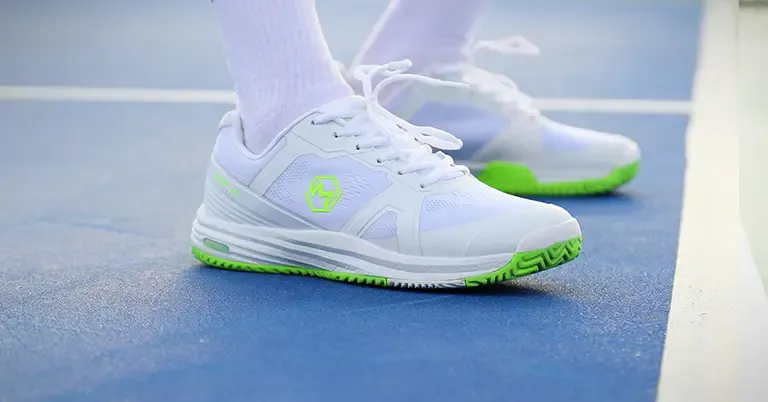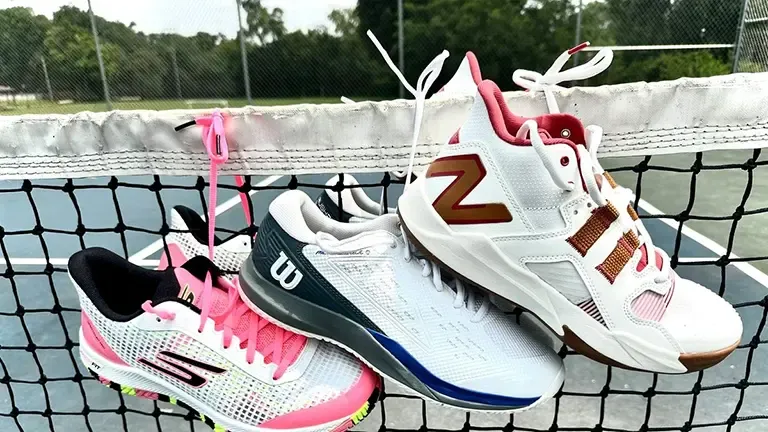Key Similarities
While pickleball and tennis may appear quite distinct at first glance, their shoe designs share several key features that cater to the dynamic movements players make during the games. Both pickleball and tennis shoes prioritize lateral support, cushioning, and durability, allowing for efficient movement on the court.

- Lateral Support: Both shoe types are designed to provide strong lateral support. This necessary feature stabilizes the foot during quick side-to-side movements, which are crucial for both sports. A well-structured shoe helps players maintain their balance and prevent injuries.
- Cushioning: Effective cushioning is vital in both pickleball and tennis shoes. The right padding helps absorb impact, especially during jumps and sudden stops, reducing fatigue and discomfort during extended play.
- Durability: Given that both sports are played on hard surfaces, the outsole of both pickleball and tennis shoes is engineered to withstand the wear and tear associated with court play. High-quality rubber compounds offer durability, ensuring the shoes last longer even with regular use.
- Grip and Traction: Another aspect where both shoe types align is in their traction capabilities. Optimized grip allows for precise movements, making it possible to pivot quickly or dodge an opponent's shot without slipping.
Crucial Differences
Despite the similarities noted above, the fundamental differences between pickleball and tennis shoes cannot be overlooked. These distinctions mainly center around the specialized needs of each sport, particularly concerning sole design, grip, and overall support.

Emphasis on Lateral Movement (Pickleball Specific)
The emphasis on lateral movement is particularly pronounced in the design of pickleball shoes. Given the nature of the game, where quick side-to-side motions are frequent and critical, pickleball-specific footwear caters to these unique demands.
- Wider Toe Box: Pickleball shoes often feature a wider toe box, which allows your feet room to move laterally without feeling cramped. This is important for comfort and injury prevention during rapid shifts in direction.
- Flexible Sole: The soles of pickleball shoes are engineered to be more flexible, affording quick pivots and effortless transitions between movements. This flexibility allows for greater agility, essential for responding to fast-paced gameplay.
- Enhanced Arch Support: Since pickleball players frequently engage in lateral lunges and sprints, adequate arch support becomes paramount. Many brands design pickleball shoes with this aspect in mind, thus facilitating better foot mechanics.
- Lightweight Materials: The materials used in pickleball shoe construction are often designed to be lightweight. This feature assists players in maintaining speed and agility on the court, allowing for quick footwork without encumbering movement.
Outsole Tread Pattern & Compound
The outsole tread pattern and the materials used in pickleball and tennis shoes vary significantly, impacting performance on different playing surfaces.
- Traction Patterns: Pickleball shoes typically feature multidirectional tread patterns that enhance grip. This allows for quick lateral movements and stops. Conversely, tennis shoes generally have unique patterns suited for specific surfaces herringbone patterns for clay courts or solid rubber for hard courts.
- Rubber Compound: The compounds used in the outsoles also differ. Pickleball shoes often employ softer rubber designed for better grip on indoor surfaces, crucial for maintaining traction during rapid movements. Tennis shoes, on the other hand, use more durable compounds to handle outdoor courts, focusing on longevity over indoor traction.
- Surface Versatility: While tennis shoes are designed for various court surfaces, pickleball shoes concentrate on either indoor or outdoor play. The ability to transition easily between lateral and straight movements is essential for pickleball, thus the sole designs vary accordingly.
Weight & Flexibility
Another notable difference between pickleball and tennis shoes lies in their weight and flexibility.
- Lightweight Design: Generally, pickleball shoes are constructed to be lighter than tennis shoes. This lightweight design allows for quicker lateral movements and rapid acceleration, crucial for the fast-paced nature of pickleball. Players often appreciate the agility that lighter shoes bring.
- Enhanced Flexibility: Flexibility is a key feature in pickleball shoes. They are designed to allow the foot to move naturally during play, making it easier to pivot swiftly and change directions. Principles of biomechanics suggest a flexible shoe can support faster response times on the court.
- Tennis Shoe Stability: In contrast, tennis shoes tend to be heavier and may possess a stiffer construction. This design is beneficial for providing the necessary stability for the intense movements and volleys characteristic of tennis play. Sturdiness can be beneficial, especially for players who engage in long matches.
- Suitable for Players’ Needs: Understanding these differences helps players make choices aligned with their playing style. Those who prioritize speed and agility might prefer pickleball shoes, while players focused on endurance and stability might find tennis shoes more suitable.
Cushioning Profile
Cushioning is another critical distinguishing factor when comparing pickleball and tennis shoes.
- Responsive Cushioning: Pickleball shoes prioritize a softer, more responsive cushioning. This is particularly beneficial for the short, quick bursts of energy required in pickleball, where players frequently engage in sharp stops and starts.
- Structured Cushioning: In contrast, tennis shoes incorporate more robust cushioning systems designed to support longer play sessions. The cushioning is typically aimed at absorbing the impact of powerful serves and long rallies, offering comfort during extended matches.
- Types of Cushioning: The materials used for cushioning can also differ. Many pickleball shoes use lightweight foams that provide adequate bounce and energy return, while tennis shoes may incorporate denser foam or gel systems designed to distribute impact over a larger area.
- Play Duration Consideration: For players who engage in long matches or thorough practice sessions, the cushioning in tennis shoes can be vital for comfort. In contrast, those focused on agility and quick movements will likely benefit from the responsive cushioning of pickleball shoes.
Comparison Table: Pickleball Shoes vs. Tennis Shoes
A visual summary can often clarify the distinctions between pickleball shoes and tennis shoes. The following table outlines the crucial differences in their features:
| Feature | Pickleball Shoes | Tennis Shoes |
|---|---|---|
| Design Purpose | Tailored for rapid lateral and forward movement. | Optimized for varied court surfaces, emphasizing stability. |
| Sole Characteristics | Flexible soles with multidirectional grip. | More rigid soles designed for durability on specific surfaces. |
| Cushioning | Enhanced cushioning for quick movements. | More substantial cushioning for prolonged support. |
| Breathability | High levels of mesh for airflow during intense play. | Moderate breathability, focused on durability. |
| Grip | Multidirectional patterns for swift transitions. | Tread optimized for specific surfaces like clay or grass. |
| Fit | Typically has a wider toe box for lateral movement. | Snug fit, potentially hindering lateral expansion. |
When Can You Wear Tennis Shoes for Pickleball?
Using tennis shoes for pickleball isn't a hard and fast rule; there are scenarios where tennis shoes might be usable in a pickleball setting.

- Outdoor Courts: If you are playing on outdoor pickleball courts where the surface may mimic that of a tennis court, tennis shoes could provide adequate grip and support. Outdoor court surfaces often require sturdier footwear.
- Casual Play: For casual play or recreational scenarios, wearing tennis shoes may not significantly impact performance. However, this situation should be approached with caution as the shoes might lack the finesse and traction ideal for serious play.
- Limited Availability: If pickleball-specific shoes are not available, and you own a suitable pair of tennis shoes, they can serve as an interim option. Just be mindful of their performance limitations.
When Should You Definitely Get Pickleball-Specific Shoes?
There are specific instances where strongly considering pickleball-specific shoes becomes essential.

- Frequent Indoor Play: If your pickleball sessions mainly occur on indoor courts, pickleball-specific shoes equipped with special rubber outsoles designed for grip and traction become crucial. They can provide superior ball control and prevent slips that might arise from slick surfaces.
- Outdoor Play Regularly: Players who frequently enjoy outdoor pickleball should also invest in dedicated shoes designed for this environment. The tire tread and durability will protect the shoe from the wear and tear of outdoor conditions while enhancing grip.
- Injury Prevention: If players have histories of foot injuries or discomfort during matches, opting for pickleball shoes can offer essential support. These shoes are often designed with an emphasis on stability during lateral movements, helping reduce the likelihood of future injuries.
- Progressing in Skill Level: For players looking to improve their game, having the right footwear contributes to better performance. The nuances of pickleball gameplay require shoes tailored to the sport's specific demands, which can directly affect performance.
Frequently Asked Questions
Considering the detailed discussions on footwear for pickleball and tennis, it is essential to resolve lingering uncertainties about shoes. If you regularly play both sports, you might wonder about the necessity of specific shoes for each activity.
Is It Dangerous to Wear Running Shoes for Pickleball?
Wearing running shoes for pickleball can be perilous due to their inherent design, which is crafted primarily for forward motion this could pose several risks.
- Lack of Lateral Support: Running shoes lack the necessary lateral support, making them ill-suited to the quick side-to-side movements typical in pickleball. This design flaw can lead to ankle rolls and other injuries during a quick pivot.
- Increased Injury Risks: The absence of specialized traction means players may slip during play, particularly on indoor surfaces. Running shoes do not provide the grip or stability required in a quick-paced sport like pickleball.
- Heel-to-Toe Drop Issues: The design of running shoes often involves a greater heel-to-toe drop focused on forward motion. This does not support the multidirectional nature of pickleball, leading to decreased performance and increased injury risks.
What’s the Biggest Single Difference Between Pickleball and Tennis Shoe Design Philosophy?
The core difference in the design philosophies of pickleball vs. tennis shoes underscores their specialized functionalities.
- Focus on Movement Styles: Pickleball shoes are engineered for lateral stability and quick directional changes, reflecting the game's requirements. Their design centers on accommodating the player's need to dash and pivot swiftly.
- Tennis Shoes for Endurance: In contrast, tennis shoe design emphasizes durability, with a focus on supporting longer matches and the pounding energy of powerful strokes. The main objective is to facilitate support through the various terrains of tennis court surfaces.
- Cushioning Emphasis: The cushioning profiles differ, with pickleball shoes using responsive materials to brace against quick, abrupt changes, while tennis shoes may favor a more substantial cushioning system that absorbs the impact of long rallies.
What Features Do Both Good Pickleball and Tennis Shoes Share?
Despite their differences, some features are shared by both pickleball and tennis shoes, which enhance the player’s experience in both sports.
- Lateral Stability: Both types of shoes are designed to enhance lateral stability, essential for swift movements in both games.
- Durable Outsoles: The outsoles are crafted from durable materials to withstand court wear, ensuring the longevity of the shoe.
- Good Cushioning: Effective cushioning is standard in both shoe types, allowing for shock absorption during jumps and quick stops, thereby reducing fatigue.
- Breathable Materials: Good shoes often incorporate breathable materials, keeping feet comfortable and dry during prolonged play.
If I Play Both Sports, Do I Need Two Pairs of Shoes?
For avid players who enjoy both pickleball and tennis, the question of whether to own separate shoes is valid and important.
- Optimized Performance: Different shoes tailor fit the unique demands of each sport. Having specialized footwear allows players to maximize their performance on both types of courts.
- Injury Prevention: Wearing shoes designed for a specific sport can mitigate the risk of injury, as they provide targeted support and cushioning.
- Versatile Use: Designated shoes help players feel confident in adapting to the nuances of either sport. Using one pair for both can lead to compromises in performance, as each type of shoe caters to different motion requirements.
Conclusion
In the ongoing comparison of pickleball vs. tennis shoes, it’s clear that the right footwear can significantly impact overall performance, comfort, and safety on the court. Whether engaging in the fast-paced, lateral shifts of pickleball or the powerful strokes and longer rallies of tennis, players need footwear that meets the nuances of each game. By investing in sport-specific shoes, athletes can ensure enhanced agility, traction, and support vital for their success.
Ultimately, whether you choose to play and compete passionately in one sport or both, understanding the underlying differences can help you choose the footwear that fulfills your athletic needs. Having the right shoes not only boosts performance but also provides the confidence to enjoy the game making each match a rewarding experience.










